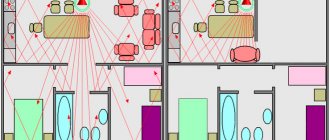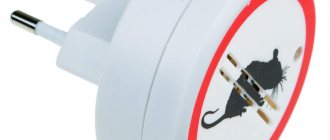Many people have heard about electric rat traps, but not everyone fully understands how these devices work, how effective they are and when, in general, it makes sense to replace more traditional means with them. Well, we’ll talk about these traps in more detail and look at a number of interesting nuances related to their use in practice.
As you can guess from the name, the operation of an electric rat trap is directly related to the use of electric current. Moreover, we are talking specifically about the destruction of animals, and not about their capture alive. An important question that should immediately arise is: isn’t such a trap dangerous for other inhabitants of the house, including people? After all, electricity... We will also talk about this later.
In general, it can be noted that electronic rat traps are very simple and convenient to use, and the effectiveness of such devices is quite high - if used correctly, they can be used to exterminate even a large population of rats in a given area...
Operating principle of electric rat traps
The operation of an electric rat trap is based on a simple principle: an animal, climbing into the rat trap and trying to pull the bait out of it, closes an electrical circuit on itself. A high voltage current passes through its body, which leads to almost instantaneous death of the animal.
In some types of traps, contacts are made on the animal's paws when it climbs into the rat trap. In other devices, the rat receives an electric shock when it touches a baited feeder. Theoretically, in the first case, the rat has a chance to escape, but there is no practical difference in efficiency between devices with different circuits: rats are equally reliably destroyed by traps of both types.
It is clear that for reliable destruction of the pest, the voltage on the electrodes of the device must be high enough. To do this, voltage converters are often used, which make it possible to convert low voltage from batteries into several thousand volts at the output. So, in some traps, a rat or mouse receives an electric shock with a voltage of up to 8000 V (although the voltage can be lower - the standard 220 V is also quite “enough” for a rat).
Due to voltage converters, some electric rat traps are autonomous, run on batteries or rechargeable batteries and do not require a connection to the network.
Bait selection
Food products make ideal bait. Rodents are always attracted to different types of food. A homemade rat trap without bait will not work, since the animals will not be interested in getting inside the killing structure. What you can choose:
- corn;
- cheese;
- nuts;
- porridge;
- bread;
- cottage cheese;
- sausage;
- smoked products.
Rats consume different types of food; it is best to choose bait with a strong odor (spoiled product)
To smell the bait, use sunflower oil without a strong aroma, which is used to process bread, porridge, grain and other cereals.
Mousetraps and rat traps have the same design features, but differ in size. A mouse grows up to 10 cm, and the length of an average rat reaches 40 cm. You should not use small traps for large rodents.
The main advantages of such devices
One of the main advantages of an electronic rat trap is the “hygienic” nature of its use. This compares favorably with poisons, which have to be spread throughout the apartment (and then be afraid that neither the product itself nor the rat poisoned by it will be found by pets), as well as mechanical traps, which, when triggered, often leave dried blood stains on the floor.
In addition, electric exterminators are for the most part very effective: in practice, with their help it is often possible to get rid of even the most cautious rats (who are wise with experience and no longer touch the poison and bypass ordinary crush traps).
Other advantages of electric rat traps:
- The compactness of the device, the ability to install it in fairly secluded and hard-to-reach places;
- Humaneness (compared to some other types of devices) - the animal dies in a trap almost instantly, without suffering from pain. This makes electric rat traps significantly different, for example, from glue traps, in which a rat can die for several days;
- Ease of use - the trap does not need to be prepared for a long time, and even disposal of the animal’s corpse is very simple and takes less than a minute (you don’t even have to touch the animal’s corpse).
Meanwhile, with all the above advantages, the electric rat trap also has certain disadvantages...
General information
Rats live not only in private houses, but also in apartments. Some apartment buildings are equipped with a garbage chute, through which rodents enter the staircase landing, and then into a person’s home. Owners of private houses and people involved in household work are faced with rodents. A distinctive feature of a rat from other types of rodents is its mental abilities, thanks to which it can survive.
In some cases, rat traps are ineffective because most people do not know how to use them correctly. In addition, a rat that has once been caught in a rat trap and survived is a difficult target to catch. Thanks to the instinct of self-preservation, she learns and subsequently avoids dangerous situations. There are known cases when the rat trap remained “loaded”, but there was no bait on the hook. There are many types of simple and very effective mechanical traps that you can make yourself at home.
Danger to humans
Rats are one of the signs of unsanitary conditions. The presence of food debris, warm rooms and humidity - all these factors contribute to their favorable existence. Multi-storey buildings are no exception. Residents of the first floors suffer especially from rodents. In addition, animals can live near a food source. Rats are very hardy and can travel long distances. They can enter the apartment through balconies, entrance doors and ventilation openings.
The main threats that rodents pose to humans are divided into two types: material and physical. The first type of threat is that they spoil food, furniture, clothing, and so on. Rats damage equipment by chewing through power cords. They destroy buildings by gnawing holes in the walls. The physical threat is the diseases they transmit to humans through their bite and feces. They carry dangerous diseases: leptospirosis, rabies, typhoid, and so on.
Features of using traps
DIY mechanical rat traps are the most reliable. The most common is the mechanical type rat trap. When an animal comes into contact with it, it dies immediately or remains until detected by a person. In addition, various types of poisons are used to kill rats, but they are not justified, since when poisoned, the rat crawls into its hole, which is located in hard-to-reach places. The rodent dies and begins to decompose, releasing a corpse-like odor.
Before using a trap (rat trap), you need to know the following rule: a rodent will not approach those traps from which it smells a human smell. You need to wear rubber gloves when setting the trap. Another rule to be aware of is that the trap must be placed against the direction the rat is moving.
Rodents move quietly and carefully near walls as they try to remain unnoticed. It is advisable to place the trap near a hole or rat feces
The rat trap is not placed in a visible place, since the likelihood of an animal getting into it is negligible.
Disadvantages of Electronic Rat Traps
Like any electrical device, electronic rat traps can pose a hazard to pets and humans if not handled correctly. However, in fairness, it must be said that many modern models of electric rat traps powered by batteries, even with a gross violation of safety regulations during operation (for example, if you stick your fingers inside), are not capable of causing serious harm to human health.
The most dangerous devices to use are those made by yourself and powered by a 220 V mains voltage. Often, the circuits of such homemade products do not provide any protection - at best, a fuse that will not save you from a life-threatening electric shock.
In general, simple mechanical rat traps with a powerful spring can be considered much more dangerous to use than modern battery-powered electric rat traps. A trap can easily break a child’s finger or a cat’s paw, while electronic rat and mouse exterminators are designed in such a way that you cannot reach the electrodes with your fingers (or paw).
And even in the worst case, although the discharge will be very unpleasant for a person, it will not be fatal (a person is about 100 times larger than a rat, and the discharge power of a battery-powered device is simply not enough to cause serious harm).
Such traps also have other disadvantages:
- High cost - prices for electronic shredders start from 2,500 rubles and reach 10,000 rubles for the most modern models. For that kind of money you can buy several dozen ordinary mousetraps, or several tunnel traps that are safe for pets and are not inferior in efficiency to electric traps;
- Dependency on power supply. If the trap runs on batteries, they will have to be replaced periodically. If the device requires connection to an outlet, then it cannot be used where there is no network;
- The need to regularly check and release traps. If this is not done, then within a few days the rat will begin to decompose right in the device.
And yet, the main disadvantages of electric rat traps are their high cost and the danger to people and pets that is greatly exaggerated in the minds of the average person. This is what limits the popularity of these devices among the people.
“When I was at my sister’s, I saw how they were fighting rats there. They have special electric rat traps for this. The rat climbs inside to get some bread, and then electrocutes it. While we were staying for a week, they caught three rats in their cellar. An excellent remedy, no brains scatter to the sides, no blood, I just took this trap, knocked it over, the rat fell into the bag - and that’s all ... "
Damage from rodents
The well-known ladies' exclamation “It smells like mice!” - not the saddest consequence of a rodent invasion on a household.
Mice and their larger relatives, rats, eat everything that is bad in kitchens, warehouses, pantries, cellars, sheds, barns, and other places where food is concentrated, often causing food supplies, especially in warehouses and in rural areas, damage comparable to fires. It’s not uncommon for them to spoil clothes, shoes and books.
In addition, rodents, leaving excrement, urine and saliva in human homes, are carriers of more than 70 infectious diseases. The ominous medieval plague epidemic, which wiped out the population of half of Europe, was brought on by rats on their paws.
And the simple appearance of rats and mice in women's company spoils the ladies' nerves and mood for the whole day.
Did you know? According to approximate calculations by scientists (since it is impossible to count accurately), there are half as many people on our planet as there are rats.
Rules of application and safety measures
Electric rat traps are quite easy to use. To catch a rat you need:
- Place bait in the device - for this there is a special feeder on the inside of the back wall of the device;
- Connect the rat trap to the network or insert batteries into it - depending on the model;
- Install the device where it can be easily reached by a rat or mouse attracted by the smell of the bait. It is advisable to choose a place to install the trap where pests are most often (where they leave their traces);
- From time to time (but at least once a day) check the indicator signals in the rat trap. Each model has its own mode of operation of the indicator, described in detail in the instructions;
- After catching a rat, you simply need to tilt the trap so that the animal falls out of it. If the corpse needs to be removed from the device by hand, the power in it is first turned off. In a model with a storage chamber, only the chamber itself is cleaned.
The Victor Rat Zapper Ultra is sold complete with a remote indicator that can be placed in an easily accessible, visible location. This is very convenient: the rat trap may be somewhere in the pantry behind a box of potatoes, and it will be difficult to look there regularly. It is enough to put the indicator on a shelf in the room and only check it. The rat catcher will only need to get it when the corresponding light comes on, indicating that the rodent has been captured.
Minced meat with onions, smoked sausage, scorched lard or bread lightly moistened with vegetable oil are good baits for rats.
Electric rat traps should only be used in areas where children and pets are not present. The exception is the Victor Multi Kill Electronic Mouse Trap, which is well protected and does not pose a danger to pets and humans.
Electric traps should also not be used outdoors. Here harmless and sometimes very useful animals - shrews, birds, hedgehogs, lizards and snakes - can climb into them and die. In such cases, the harm to the site will be greater than the benefit from destroying the pests with a trap.
Fine mesh construction
Manufacturing requires welded material with small cells. It is necessary to prepare a tool for metal processing, since you will have to cut the mesh. Each component must have a rectangular shape. This will result in a cage with dimensions of 60x30x20 cm. To connect the parts, it is not necessary to use a welding machine. You can use simple wire or clamps.
It is recommended to equip a handle to move the product from place to place. It is better to place the element at the top of the structure. The front door must be equipped with a spring mechanism.
You will need a piece of twine or cord. It is necessary to place the bait close to the back wall. At one end of the cord there is a hook on which the food is located. The opposite end of the rope runs along the top of the structure and is secured to the trap door. If a rodent gets inside, an attempt to eat the bait will end with the door slamming shut.
Is it possible to make an electronic rat trap with your own hands?
It’s easy to make an electronic rat trap yourself from readily available radio components. An important task in this case is to find a reliable housing in which, in fact, all the elements will be placed and which will serve as the trap itself. The easiest way for this purpose is to use a regular food container, in which a hole with a diameter of 6-7 cm is cut out for the animal to enter.
Next, two metal plates are placed on the bottom of the container so that the distance between them is more than 1 cm (more than the length of the rat’s paw). This will avoid a situation where the animal “locks up” only one paw, it gets burned, but does not die and runs away. If there is one or more paws on one plate, and another on the other, then the current will flow through the animal’s body, which will lead to death.
An option is possible when power is supplied to one contact at the bottom of the rat trap and to the hook on which the bait hangs. In this case, the likelihood of the rodent dying when the trap is triggered will be even higher.
The drawing below shows one of the options for the electrical circuit of the device:
Such a trap is installed where the rat is likely to find it. After catching the animal, the rat trap must be unplugged from the outlet, the capacitors must be discharged with a conductive object (insulated from hands), and then the animal’s carcass must be removed.
It should be understood that the danger of such a homemade device for humans and pets is incomparably higher than in the case of using a factory device powered by batteries.
“We bought a Victor electric rat trap, it looks solid, right for the money. We put it in the nightstand under the sink, where the trash can is, and began to wait. Nothing in the morning. In the evening, too, nothing, but no one climbed into the bucket. Every other day in the morning I open the bedside table and the tail is sticking out of the trap. I took it, turned it over, and the rat fell out. Everything is fine, no blood. It’s a good rat trap, it works.”
Options for replacing an electric rat trap with other types of traps
No matter how simple and convenient electric rat traps are, in many cases one or another of their shortcomings does not allow home owners to use them.
In such cases, more traditional means can be used with the same reliability:
- Conventional mechanical traps are much cheaper and about as simple and effective to use. When installed in a special bait house, they will not harm anyone. If it is not a problem for you to remove a rat with a broken spine or a crushed skull from a trap, then such devices can be used;
- Tunnel strangler traps are completely safe, but they work well mainly only for catching mice;
- Live traps - these devices are suitable for situations where there are pets or children living in the house, and you don’t want to risk their health. They are good if you do not want to kill a rat or mouse, but only plan to catch it, take it away from the house and release it;
- Rodent repellent glue and glue traps based on it are perhaps the most undesirable and inhumane means of fighting rats. Stuck rodents will die for a long time on the sticky surface, or you will have to finish them off yourself.
A good option (if used correctly and carefully) is poison for rats and mice. They are very inexpensive, effective, and if placed in bait houses, they are quite safe - neither children nor pets can get them.
If you have personal experience using electric rat traps, be sure to share the information by leaving your review at the bottom of this page.
The appearance of mice in the house is a problem that requires drastic measures. You need to get rid of rodents, because they spread dangerous infections (including parasitic ones) and spoil food. An effective way to deal with uninvited guests is an electric mousetrap, which eliminates animals using a high-voltage discharge.
We catch the pest alive in the house: quickly and inexpensively
There are several options to quickly catch a rat in the house with homemade devices. The most effective of them, which have been repeatedly tested in practice, are described below.
Option 1:
- Take a saucepan (or other available container), attach a piece of sausage, lard or bread with vegetable oil to the middle of its wall;
- The pan is turned upside down and placed on the floor;
- One edge of it is raised, and an unstable support is placed under it (for example, a nail or a jar lid on the edge). The edge of the pan rests against the support.
When a rat crawls under the pan for the bait, it is highly likely to push the support, and as a result, the pan will cover the rodent. Even if the rat is very careful and does not touch the support, the animal under the pan will rest its front paws on its wall to get the bait, and will still move the pan from the support.
Option 2 – allows you to catch a rat alive using an unstable bridge over a container:
- A stool is placed next to the empty open barrel, on which a small plank is placed, about half of which will hang over the neck of the barrel;
- The bait is placed at the very edge of this overhanging board.
- The rat will try to get to the bait, the board with it will tilt and fall into the barrel.
Option 3 – original trap made from a plastic bottle:
In addition to the free nature of the described traps, their beauty lies in their complete safety - neither pets nor children risk injury if they accidentally stumble upon such a device.
The main problem with a live trap is the need to decide what to do with the caught rat. It’s good if there is a cat or dog living in the house, which will gladly save the owner from this problem. If there is no such pet, then you will either have to kill the rat yourself (which not everyone can do), or spend time and effort to release it away from the house.
If you don’t want to do either one or the other, then you shouldn’t catch a rat alive.
It is also important to remember that a caught live rat may well bite until it bleeds if you try to pull it out of the trap with your bare hands or wearing thin gloves. Such bites are quite painful, and, in addition, when bitten, the animal can infect a person with a dangerous infection. Therefore, all manipulations with a triggered live trap should be carried out wearing thick construction gloves.
Therefore, all manipulations with a triggered live trap should be carried out wearing thick construction gloves.
Types of electric mousetraps
The action of destruction systems is based on a discharge of electric current, which kills a rodent caught in a mousetrap. The device is a plastic box. The bait is inside. The device may have mazes to disorient the rodent. When the device is ready for use, the green indicator lights up.
Electric traps differ from ultrasonic repellers in the effect they have on rodents. The first destroy the animals, the second expel them from the premises.
Device classification
Electronic mousetraps differ from each other in the following ways:
- Location of electrical discharge. In some devices, the energized plates may be located at the bottom. The animal dies when it touches them with its paws. In others, the circuit closes when you touch the feeder.
- Power source (batteries, electrical network 220 V).
- Number of entrances, tunnels (from one to six).
- Number of rodents caught. The device, designed for large populations, contains a storage container for collecting carcasses (up to 10 individuals). In small mousetraps, a chamber is installed for one individual.
How to make it yourself
You can make an electrical device against rodents yourself. Financial expenses in this case are minimal, and the efficiency is not inferior to purchased analogues.
Necessary materials
For a homemade electric rat trap, you need to prepare the constituent elements, namely:
- battery (12 Volt);
- aluminum or tin plates;
- capacitor (electric charge converter, 380 Volt);
- plywood sheet, wooden board (base).
You will need hardware and wires to connect electricity.
Step-by-step instruction
A homemade electric mousetrap can have different designs, but the operating principle is the same. Death occurs from a discharge of electricity.
How to make a rat trap from a battery:
- Metal plates are attached to the substrate with self-tapping screws (nails) (the distance between them is 1-2 cm).
- Wires are connected from the battery through the capacitor to the plates. To one (+), to the other (-).
- Bait is placed on the metal part of the trap.
- On the approach to the food, a tunnel is built that imitates a hole. You can make it from a plastic bottle. The structure is installed so that the rodent steps on two plates at the same time.
The body of the animal serves as a conductor of electric current. The plan for eliminating rodents is simple. By stepping on both electrodes at once, they close the circuit on themselves and die from the discharge within 2-3 seconds.
Additional Information! As bait, you need to use products with a pronounced aroma. Smoked lard and bread fried in unrefined sunflower oil will attract mice faster than cheese. Rats react to the smell of fresh meat and sausage.
Killing Loop
A convenient killing device for catching pests is made from bars and wire. These homemade rat traps are put together step by step:
- Prepare a wide beam 40 cm long.
- A hole with a diameter of 9 cm is made in the material.
- Stepping back from the edge of the workpiece by 6 cm, create a notch with a large depression.
- A powerful spring is attached to the top of the device with metal brackets.
- 4 cm are removed from the cut, 2 small symmetrical holes are made in the upper part.
- 2 more holes are drilled at the bottom of the wood, a strong thread is inserted into them, passed through the upper holes and tied to a spring.
- A loop is made from thin steel wire. It is installed in the file and tied to the edge of the spring.
- The structure is installed opposite the hole and equipped with food.
The principle of the noose trap is to suffocate the rodent
The principle of operation is simple: the animal will head towards the bait, and the stretched threads will block its path. The rat will gnaw through the obstacle, at that second the spring will be released, rise sharply upward along with the loop and strangle the pest.
How to choose a ready-made model when purchasing?
To choose an effective means of eliminating mice, in the store you need to study the technical characteristics of the models presented and compare them with your needs.
Recommendations for choosing a mousetrap:
- Depending on the number of rodents, multi- or single-place devices are chosen.
- The plastic body of a good trap should not emit a strong chemical odor.
- If there is no electrical outlet in the room, you need to buy a device that runs on batteries or a battery.
- Safety in use. Equipment must be protected from contact with dangerous elements.
- Equal effectiveness from mice and rats.
In order for the anti-mouse device to be of high quality, it is necessary to purchase certified products.
Iron bucket
This device effectively catches both mice and rats. For the work you need available materials. Creating a homemade product with a step-by-step description:
- Pour table salt into a container with warm water. It is stirred until it dissolves.
- Wood shavings or sawdust 1-2 cm thick are added to the liquid. The husk will cover the entire water surface, and the saline solution will prevent it from sinking.
- Bread crumbs or other products are placed on the camouflage coating.
- The bucket is placed on a chair close to the kitchen furniture. The edge of the container is placed at the same level as the table.
A rodent, tempted by an easily accessible treat, will quickly run into the sawdust and drown.
TOP 5 popular models
Electric traps for rats are modern devices that destroy rodents almost instantly, without a trace of blood. Animal carcasses can be disposed of in a waste container without contact.
Antirats-190
The rat trap retains its working properties at temperatures down to -30 C and high humidity (95%). The voltage is located inside the plastic box, so the device is safe to use. The design is of a tunnel type. There are 6 inlet holes on the side wall.
Size W*D*H (cm) - 13*22*11. Power sources: C batteries (4 pcs.), el. net.
Manufacturer: Russian company i4Technology. The company's products are reliable.
Victor
The trap is designed in the form of a tunnel, which protects against accidental electric shock when touching the inside. It is equipped with 2 tension plates.
Power source - AA batteries (4 pcs.). The charge is enough for 100 rodents.
Victor Multi Kill
The rat trap has 2 entrances and a storage container. There are 3 plates in the discharge compartment. Its feature is an automatic revolution after a discharge. The dead animal ends up in a chamber, the size of which allows you to collect up to 10 carcasses.
Recharging occurs automatically after each operation.
Power source - “C” batteries (4 pcs.). The kit is designed for 150 mice or 50 rats.
Electronic Mouse Trap
The Victor brand mousetrap has a cone grip technology that captures the animal. Electric discharge for 5 seconds. kills a rodent. The entrance imitates a hole, located near the wall, in the path of the mouse. Beveled tunnel partitions protect fingers from 2 tension plates.
Power source: 4 AA batteries.
The Victor brand is manufactured by the American company Woodstream Corp, which has experience in rodent control since 1898. The popularity of the products was brought by the use of innovations.
- Power cut off when the door is open.
- Use of safe materials.
- LED notification method.
- Reliability of shockers.
- The design of electronic equipment is designed so that the human hand does not touch dangerous parts.
The disadvantage is the high cost of traps (from 1500 rubles). The price depends on the model.
GH-190
An 8 kW electric discharge destroys the rodent. In offline mode it performs up to 40 discharges. Made from fireproof plastic. The top cover is removable, allowing for hygienic cleaning. The device is designed for 1 individual. After removing the animal’s body, the apparatus must be washed and dried.
The device must be used in a place inaccessible to children and pets.
Dimensions W*D*H (cm) - 13*21*11.
Power sources: from a 220V network, from 4 “C” batteries.
The manufacturer of the rat trap is Chinese.
Electric mousetraps are a humane way to kill rodents. The death of the animal occurs instantly, in contrast to mechanical methods of killing, where the animal dies a painful death: in a bucket of water, on an adhesive backing, clamped in a trap.
Note! When using an electrical apparatus, care must be taken. Install the device in accordance with the instructions.
The animal must be removed immediately after death, preventing decomposition.
Conclusion
Electric mousetraps are a technological invention for eliminating pests of the mouse family.
- The principle of operation of traps is a high-voltage discharge of current, which leads to the death of rodents.
- An electric rat trap is quite easy to make with your own hands. Basic electrical knowledge will come in handy.
- You need to choose a ready-made device based on your needs, safety and reliability of the trap.
- There are options for rat traps from various companies on the market. The TOP 5 includes the best models from well-known manufacturers.
The electronics in the traps allow you to monitor readiness for operation, dead rodents in the container, and charge level.
This diagram is taken here
If you don’t want to do it yourself, you can buy a ready-made device; below, see a brief overview of the most popular models of electronic mousetraps.
Review of Russian manufacturers of electronic mousetraps: victor, sititek antirat, Ecosniper, Yastreb
For those who are far from amateur, a wide selection of patented electronic traps is offered. Let's take the most common ones as an example:
Electronic mousetrap Victor
Powered by batteries, one set is enough to destroy up to a hundred individuals. A special indicator will show that the mouse has been caught and will also indicate that the battery is low;
Video review of the Victor electronic mousetrap
Electronic mousetrap Sititek Antirats
Works both from batteries and from a 220V network. The patented shape of the tunnels prevents a mouse that has climbed inside the trap from getting out;
Video review of the electronic mousetrap Sititek Antirats
Electronic mousetrap Ecosniper
Rodent exterminator Yastreb PP (electric mouse trap)
A universal, compact and reliable device, when a rodent gets into the box, a discharge of 8000-12000 V passes through it - the rodent dies instantly, we recommend this device - ideal price-quality ratio











